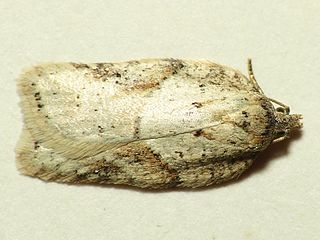
The Luna moth also known as the American moon moth is a Nearctic moth in the family Saturniidae, subfamily Saturniinae, a group commonly known as giant silk moths. It has lime-green colored wings and a white body. The larvae (caterpillars) are also green. Typically, it has a wingspan of roughly 114 mm (4.5 in), but can exceed 178 mm (7.0 in), making it one of the larger moths in North America. Across Canada, it has one generation per year, with the winged adults appearing in late May or early June, whereas farther south it will have two or even three generations per year, the first appearance as early as March in southern parts of the United States.

Prunus virginiana, commonly called bitter-berry, chokecherry, Virginia bird cherry, and western chokecherry, is a species of bird cherry native to North America.

Macaria brunneata, the Rannoch looper, is a moth of the family Geometridae. The species was first described by Carl Peter Thunberg in 1784. It is found in Siberia, Japan, and northern and mountainous parts of North America, and throughout Europe, though in Britain it is largely or entirely restricted to mature forests in central Scotland.

Haimbachia is a genus of moths of the family Crambidae.

The palmerworm is a moth of the family Gelechiidae. It is found in eastern North America.

The shy cosmet moth is a moth of the family Cosmopterigidae. It is known from all of Europe, as well as Asia, Australia and New Zealand. It is also present in North America, where it is distributed from Nova Scotia to Virginia, west to Oklahoma and north to Ontario. The habitat consists of fens and marshes.

Acleris logiana, the black-headed birch leaffolder moth or grey birch button, is a moth of the family Tortricidae. It was described by Carl Alexander Clerck in 1759. It is found in most of Europe, except Ireland, Portugal, most of the Balkan Peninsula and Ukraine. It is also found in North America, the Russian Far East, Korea and Japan.
Haimbachia arizonensis is a moth in the family Crambidae. It was described by Hahn William Capps in 1965. It is found in North America, where it has been recorded from Arizona.
Haimbachia cochisensis is a moth in the family Crambidae. It was described by Hahn William Capps in 1965. It is found in North America, where it has been recorded from Arizona.
Haimbachia diminutalis is a moth in the family Crambidae. It was described by Hahn William Capps in 1965. It is found in North America, where it has been recorded from Oklahoma and Texas.
Haimbachia floridalis is a moth in the family Crambidae. It was described by Hahn William Capps in 1965. It is found in North America, where it has been recorded from Florida.

Haimbachia fuscicilia is a moth in the family Crambidae. It was described by George Hampson in 1910. It is found in Zambia.
Haimbachia indistinctalis is a moth in the family Crambidae. It was described by Hahn William Capps in 1965. It is found in North America, where it has been recorded from Texas.
Haimbachia pallescens is a moth in the family Crambidae. It was described by Hahn William Capps in 1965. It is found in North America, where it has been recorded from Arizona.
Haimbachia placidellus, the peppered haimbachia moth, is a moth in the family Crambidae. It was described by Frank Haimbach in 1907. It is found in North America, where it has been recorded from New York and Massachusetts to South Carolina, west to Tennessee.
Haimbachia proalbivenalis is a moth in the family Crambidae. It was described by Stanisław Błeszyński in 1961. It is found in Nigeria, the Gambia and India.
Haimbachia proaraealis is a moth in the family Crambidae. It was described by Stanisław Błeszyński in 1961. It is found on Mahé in Seychelles and in South Africa and Zimbabwe.
Haimbachia squamulella is a moth in the family Crambidae. It was described by Zeller in 1881. It is found in North America, where it has been recorded from Maryland to Florida and Texas, west to Illinois.
Haimbachia strigulalis is a moth in the family Crambidae. It was described by George Hampson in 1896. It is found in India, Sri Lanka and China.
Digrammia pallorata is a species of moth in the family Geometridae. It was described by Douglas C. Ferguson in 2008 and is found in North America, where it has been recorded from Utah, Colorado, Nevada, Texas, New Mexico, Arizona and California.





